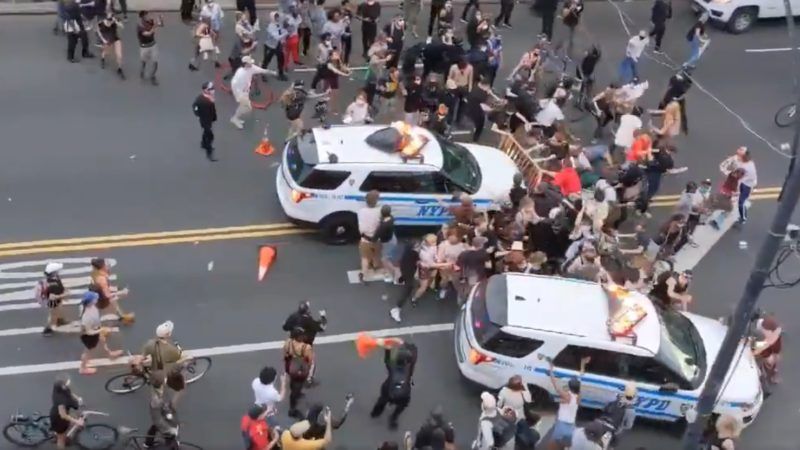Nation's Cops Seem Determined To Demonstrate Why People Are Protesting Them in the First Place
Aggressive police tactics are likely to worsen the situation.

It's already a surreal scene: The National Guard and local police are marching through a leafy neighborhood in Minneapolis. Then the shooting starts.
Tanya Kerssen was standing on her front porch filming the procession of armored vehicles and riot gear–clad troops rolling through Whittier, a neighborhood a few blocks north of where protests over the killing of George Floyd, an unarmed black man, had recently turned into riots. The National Guard had been called in to help restore order and enforce an 8 p.m. curfew set by Minnesota Gov. Tim Walz. Kerssen was complying with that order—the curfew applies only to public spaces, not private ones like residences, porches, or front yards—but she became a target anyway.
"Light 'em up!" someone can be heard shouting in the video. Then bean bag rounds and paint canisters are fired at Kerssen and others, who quickly flee inside.
Share widely: National guard and MPD sweeping our residential street. Shooting paint canisters at us on our own front porch. Yelling "light em up" #JusticeForGeorgeFloyd #JusticeForGeorge #BlackLivesMatter pic.twitter.com/bW48imyt55
— Tanya Kerssen (@tkerssen) May 31, 2020
The video is shocking, but it was hardly the only scene of apparently unnecessary policy brutality to be captured by smartphones and TV news cameras on Saturday, as peaceful protests in many cities across the country turned violent once again. Rather than helping to lower the tensions and restore peace, however, aggressive police tactics are likely going to worsen the situation—after all, the protests began because Minneapolis cops used unnecessarily brutal tactics to subdue and ultimately kill Floyd.
In Atlanta, cops smashed a car's windows and tasered the occupants while TV cameras rolled. (Those two officers were fired on Sunday, according to The New York Times.)
https://twitter.com/imactuallynina/status/1266912627193774080?s=09
In New York City, a cop ripped off a protester's face mask to pepper-spray him at point-blank range while the protester had his hands raised to surrender.
https://twitter.com/Sifill_LDF/status/1266928343141752833?
And elsewhere in New York City, cops literally drove into a crowd of protesters.
https://twitter.com/rob_bennett/status/1266894785375240193
Reporters who were on the scene to cover protests in many cities were not spared. Cops in Minneapolis shot rubber bullets at an MSNBC camera crew during a live shot with reporter Ali Velshi, fired tear gas at reporters, and reportedly shot out the windows of a car driven by a Minneapolis Star Tribune reporter, bloodying the man inside.
It is important to remember that photos and videos of clashes between protesters and police can omit critical context. They are snapshots of wide-ranging and chaotic scenes, and often do not tell the whole story.
It's also important to keep in mind that the police do not have a monopoly on senseless violence. Protesters looting private businesses, setting fire to buildings, and destroying public property do not get a pass for their actions. Such violence should stop.
Still, it is exactly when tensions are running so high that the police, National Guard, and other law enforcement personnel must keep their cool. Driving a squad car through a group of protesters is never justified. Neither is firing potentially harmful projectiles at Americans who are peacefully standing on their own property, exercising their First Amendment rights.
Officials in charge of the law enforcement responses to this weekend's protests could learn a lesson from Chris Swanson, the sheriff of Michigan's Genesee County. Swanson was caught on video Saturday removing his helmet and telling his officers to lay down their batons. He spoke directly to a group of protesters, encouraging peaceful protest and denouncing the actions of cops like the ones who killed George Floyd.
Genesee County Sheriff (Flint, Michigan) Chris Swanson put down his helmet and baton and asked protesters how he could help.
The protesters chanted "walk with us" so the Sheriff joined — and walked alongside the protesters in solidarity.
Leadership.????❤️ https://t.co/Vs3941C2o8
— Rex Chapman???????? (@RexChapman) May 31, 2020
Enforcing a curfew is not a license to commit violent acts. Doing so will only encourage more violence. If cops show up to today's protests looking for another fight—or behaving like an occupying army—they are likely to find one.



Show Comments (264)